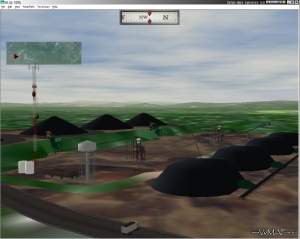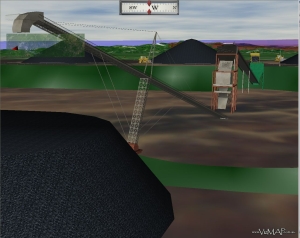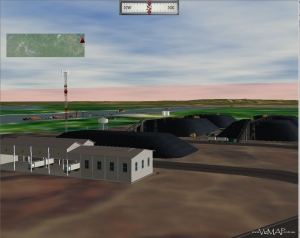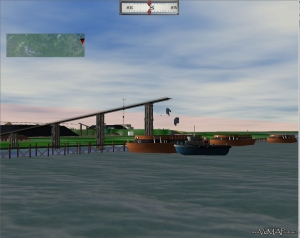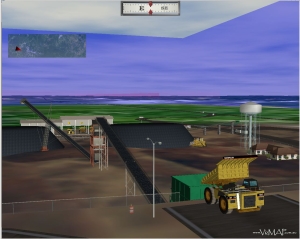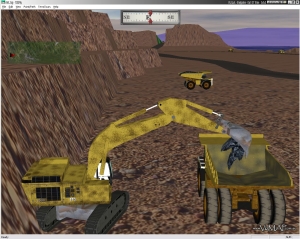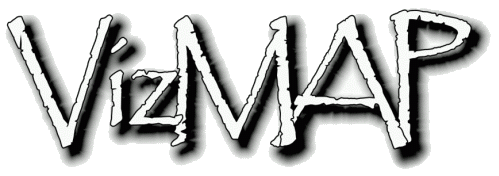|
|
vol 4 num 5

from VizMAP – letting you see where you stand…
Volume 4 Number 5
|
About VizMAP
VizMAP Pty Ltd, is a leading supplier of terrain Visualisation and related services to the defence, GIS, environmental, mapping, mining and exploration industries, engineering and construction firms, developers and planners, as well as government administration departments dealing with land, transportation and the environment.
VizMAP’s products are designed to be run on reasonably to highly configured graphics computers (PC, Linux and Unix) for public display, group training, mission rehearsal, environmental monitoring, etc. and to enhance management decision making.
VizMAP is headquartered on Queensland’s Sunshine Coast (Australia) with affiliation in Asia, Europe, Africa and the USA and thereby provides support and services to customers worldwide.
If you need to visualise anything geographic, e-mail VizMAP here with the details.
For more information about VizMAP visit the VizMAP Web site at http://www.vizmap.com.au.
|
VirtualGeography
Subscription
Details
To subscribe to VirtualGeography,
click here.
To unsubscribe from VirtualGeography,
click here.
|
A Moment’s Notice
"There is nothing… absolutely nothing… half so much worth doing as simply messing about in boats" — Ratty, Wind in the Willows

|
|
VirtualGeography – the newsletter
|
| G’Day… and Welcome to VirtualGeography |
from here |
| Welcome to another free VirtualGeography from VizMAP Pty Ltd.
VizMAP has been busy this month creating Coal and Commodity databases using Flash for the Queensland Government Department of Natural Resources and Mines and helping with the installation of another GeoSim Helicopter Part Task Trainer at Chopperline in Caloundra, Queensland. Never a dull moment here.
If you didn’t already know, VirtualGeography is a collection of interesting snippets from all over the shop, dealing with industry issues concerning the computer based visualisation of geography and a few other associated (or otherwise) interesting bits and pieces. You are receiving this either because you subscribed to VirtualGeography or you have had recent dealings with VizMAP Pty Ltd. If you do not wish to receive further instalments of VirtualGeography, just click on the unsubscribe link at the bottom of this e-mail.
A new VirtualGeography is pushed out every now and then when we’ve collated enough interesting bits and pieces, which shouldn’t be too big a drain on your mailbox if you’re not already subscribed (of course it won’t be a drain on your mailbox if you ARE subscribed, either  ). The regularity of the distribution may vary depending on what else is going on at VizMAP at the time. If you know of anyone who might like to get VirtualGeography, feel free to forward this to them and ask them to subscribe. By the way, subscription and unsubscription details are at the bottom (click here). ). The regularity of the distribution may vary depending on what else is going on at VizMAP at the time. If you know of anyone who might like to get VirtualGeography, feel free to forward this to them and ask them to subscribe. By the way, subscription and unsubscription details are at the bottom (click here).
So, g’day to all you enthusiasts requiring to visualise and simulate both urban and rural geographic information (GIS), cartography, photogrammetry, remote sensing, digital elevation modelling (DEM) and general mapping.
By the spelling of "Visualisation" you may have already guessed that we’re not US based – that’s a good thing, or at least not a bad thing. This comes to you from Mooloolaba on the Sunshine Coast of Queensland, Australia, where it’s beautiful one day and perfect the next. As a postscript to that, you can have a look at the Mooloolaba beach, now, 800m from where I sit as I write this, here.
|
The link between visualisation and mapping may seem a little esoteric if this is your first encounter with this sort of stuff, but let me tell you, the bond is significant… but enough of that: on with the show… I hope you like it. Any feedback you might have is highly appreciated. E-mail me here to make your comments.
Enjoy…
Graeme Brooke
VizMAP Pty Ltd
|
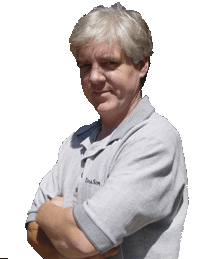 |
P.S. You’ll need an active internet connection to view any images that are in the content. We’ve done it this way to keep the size of the e-mail to a minimum.
|
| |
Back to Top |
| The Industry’s Two Cents Worth… |
| Imminent release of TerraTools v.3.0 |
from TerraSim |
| TerraSim is about to introduce TerraTools 3.0, the latest and most powerful release of its efficient geospatial database construction product line. TerraTools 3.0 rapidly constructs simulation databases using DoD/NGA/USGS source data, imagery, CAD and GIS data in a Windows environment. TerraTools natively supports multi-threaded database processing and allows up to four times parallel processing with a dual processor Windows 2000 or XP workstation using a single TerraTools license node. The TerraTools Project Flowgraph Architecture allows you to maximize your investment in commodity workstations without resorting to specialized hardware configurations or additional software licenses.
With a focus on detailed urban operations, TerraTools supports the parametric generation of complex visual geometry critical for MOUT, with a high degree of automation. TerraTools exports fully correlated databases in a variety of formats to support visual runtime environments, constructive simulation, computer generated forces (SAF), and 3D physical model construction.
TerraTools 3.0 has added a number of important new features and algorithmic enhancements to make database generation significantly faster and simpler to use. Significant new developments include:
- Enhanced OmniWizard for automatic Project Flowgraph generation
- Progress bars showing multi-threaded process activity and execution time
- Support for ECW compressed imagery for large area photo-textures
- Supports texture compression for exported databases
- Support for multi-textures and lightpoints
- Exporter enhancements for OpenFlight 15.7 – 16.0
- SEDRIS 4.0 export support
- Enhanced support for OTB and DISAF including MES building generation
- OneSAF OOS export using OTF Build 28 and UHRB Version 2 support
- Integration of LIDAR and range data for urban modeling
- Automated building interior generation supporting MES and UHRB.
- Improved generation of underground structures from CAD or facility map drawings
- Improved linkage to BAE Systems SOCET SET 5.2 for rapid geospatial data collection and automatic data visualization
- Export and import to 3D Studio Max for visual effects customization
TerraTools 3.0 will be shipped to current customers in early 2006 at no additional charge as a benefit of our TerraSim product maintenance upgrade policy.
In addition to the TerraTools 3.0 release, and in conjunction with I/ITSEC, TerraSim is releasing TSGFly version 5.0 and TerraTours 3.0. TSGFly is the TerraTools 3D viewer, which is included with TerraTools and is freely distributable by end users. It is also available for download by our DoD customers with access to the SIPRNet and JWICS.
New and improved features in TSGFly 5.0 include:
- Display of database classification markings
- Display of multi-textures and lightpoints
- Improvements to point location and line distance measurement tool
- Faster computation of area-of-effect display
- Improved line-of-sight tool with measurement readout
- Menus for database jump points and flight/drive path settings
- Interactive setting of dynamic model point markers
- User control of flood plane visualization
- Interactive labeling of objects of interest
- Customizable camera zoom and sizing
- Autosave for user defined environmental settings including sky dome, cloud movement, haze, fog, and time-of-day
TerraTours is a unique, interactive 3D viewer that allows users to query objects in the visualization to gather and display associated multimedia (video, audio, photographs), architectural design files, powerpoint presentations, and all source data attribution. TerraTours is designed for customers who wish to develop their own intelligent information fusion applications using a 3D geospatial visualization as the focal point for user interaction.
TerraTours 3.0 builds on the display capabilities of TSGFly, while offering several significant new features for data integration and query including:
- Enhanced file and attribute query customization
- Dynamic display of data markers indicating information hotspots
- Dynamic augmentation of object information within the TerraTours viewer
- Interactive generation and 3D positioning of information object reference points
- User customization to tailor TerraTours information display
Upgrades to TerraTours 3.0 are available at no charge to current TerraSim customers, as a benefit of our customer maintenance upgrade policy.
|
| Read that full story here |
Back to Top |
| Hardcore Stuff (hardware bits)… |
| Naval Research Laboratory Leverages SGI Visualization and Storage Solutions to Advance Ocean, Atmospheric and Space Sciences |
from SGI |
| 128-Processor Silicon Graphics Prism and SGI InfiniteStorage TP9700 RAID Array Enable Scientific Breakthroughs
ORLANDO, Fla. I/ITSEC 2005, Booth 101, (Nov. 29, 2005)—Silicon Graphics (OTC: SGID) today announced that the Naval Research Laboratory (NRL) in Washington, D.C. has purchased SGI® visualization and SGI® InfiniteStorage solutions to help visualize, store and share data for critical applications, including immersive real-time visualization of satellite imagery, computational fluid dynamics, ocean and weather modeling, and space physics.
"NRL is the premier scientific research laboratory within the Department of Defense supporting scientists from various disciplines such as chemistry, computational fluid dynamics, biochemistry, space physics, and many others," said Thomas Stanley, director of defense and intelligence, SGI Federal. "The lab needed a visualization solution that was powerful enough and versatile enough to accommodate many different types of scientific applications. The Silicon Graphics Prism system is designed from the ground up to solve the most challenging visualization problems facing scientists and engineers."
A complete, advanced visualization system for Linux® and one of the largest Silicon Graphics Prism™ systems in the U.S. powered by 128 Intel® Itanium® 2 processors was specifically designed to help technical professionals like those at NRL address some of the world’s most critical problems. With the Silicon Graphics Prism, SGI has combined standards-based Intel® Itanium® 2 processors and the Linux operating environment with SGI’s world-renowned advanced graphics for unbeatable visual performance and shared-memory architecture.
One of the missions of the visualization laboratory at NRL is the development of new techniques, algorithms, and methodologies to cope with the very large datasets that are being created by the scientific community that NRL serves. In particular, the area of computational fluid dynamics and GIS image analysis research have yielded terabytes of data that researchers at NRL extract and analyze for important flow features buried within these huge datasets.
Using a Silicon Graphics Prism visualization system and SGI® InfiniteStorage technology, NRL has created a DoD-wide resource for researchers to visualize their complex data, store it and share it among multidisciplinary teams. This resource makes possible the kinds of scientific breakthroughs required to advance a broad range of scientific research, technology and advanced development directed toward maritime applications that are vital to conducting U.S. Navy and Marine Corps operations in the 21st century.
"We have a host of real-world scientific visualization problems that are benefiting from this visualization-storage solution from SGI," said Dr. Hank Dardy, chief scientist for advanced computing at NRL’s Center for Computational Science. "Built on the SGI NUMAflex shared-memory architecture, our Silicon Graphics Prism visualization system has the large, complex data memory functionality we needed for our real-time technical environments. In addition, with an SGI storage area network coupled with the CXFS shared filesystem, we can read and write data directly over the SAN to and from disk, eliminating duplication and bottlenecks for our data-intensive applications."
Earlier this year NRL purchased a 128-processor Silicon Graphics Prism visualization system, powered by Intel Itanium 2 processors and running the Linux® operating environment. To store huge volumes of data, the lab installed 56TB of SGI® InfiniteStorage TP9700 Fibre Channel RAID array, the industry’s first Fibre Channel storage array equipped with 4Gb per second interfaces, whose disk space is shared as an SGI InfiniteStorage CXFS™ clustered filesystem. By eliminating network data overhead, latencies and copies, CXFS enables the typical data-intensive workflow to complete 20 to 80% faster, while reducing the administration overhead, speeding backups and reducing disk needed.
Government research laboratories like NRL are also increasingly turning to InfiniBand interconnect solutions to dramatically improve performance, efficiency, scalability and overall network reliability. SGI recently reconfigured the TP9700 at NRL to utilize new native InfiniBand host connectivity.
SGI InfiniteStorage disk arrays are built on Engenio technology that are specifically designed to meet the demanding needs of high-performance computing environments such as NRL that require InfiniBand, the leading standard for HPC server interconnects. InfiniBand is the only 10Gb per second transport that enables industry standard servers to be clustered together for reliable, available, scaleable and high performance enterprise computing. The InfiniBand solution for the SGI® Altix® family of servers addresses typical bottlenecks and provides technical customers with a world-class clustering solution for their most demanding application workloads.
|
| Read that full story here |
Back to Top |
| Softcore Stuff (software & data bits)… |
| SRTM Documentation |
from Space Imaging |
| The SRTM data sets result from a collaborative effort by the National Aeronautics and Space Administration (NASA) and the National Imagery and Mapping Agency (NIMA), as well as the participation of the German and Italian space agencies, to generate a near-global digital elevation model (DEM) of the Earth using radar interferometry. The SRTM instrument consisted of the Spaceborne Imaging Radar-C (SIR-C) hardware set modified with a Space Station-derived mast and additional antennae to form an interferometer with a 60 meter long baseline. A description of the SRTM mission, can be found in Farr and Kobrick (2000).
The SRTM-1 and SRTM-3 are preliminary terrain height data sets. NASA has taken significant efforts to avoid confusion of the SRTM-1 and SRTM-3 digital elevation models with the NIMA standard (Digital Terrain Elevation Data) DTED-1 and DTED-2 terrain height data sets. The SRTM-1 and SRTM-3 data products result from special processing of the SRTM data in response to requests from Principal Investigators selected under NASA’s Solid Earth and Natural Hazards Program, as well as other special requests from NIMA and NASA. The SRTM-1 and SRTM-3 data are preliminary products distributed for evaluation by the research and applications user community.
Synthetic aperture radars are side-looking instruments and acquire data along continuous swaths. The SRTM swaths extended from about 30 degrees off-nadir to about 58 degrees off-nadir from an altitude of 233 km, and thus were about 225 km wide. During the data flight the instrument was operated at all times the orbiter was over land and about 1000 individual swaths were acquired over the ten days of mapping operations. Length of the acquired swaths range from a few hundred to several thousand km. Each individual data acquisition is referred to as a "data take."
SRTM was the primary (and pretty much only) payload on the STS-99 mission of the Space Shuttle Endeavour, which launched February 11, 2000 and flew for 11 days. Following several hours for instrument deployment, activation and checkout, systematic interferometric data were collected for 222.4 consecutive hours. The instrument operated virtually flawlessly and imaged 99.96% of the targeted landmass at least one time, 94.59% at least twice and about 50% at least three or more times. The goal was to image each terrain segment at least twice from different angles (on ascending, or north-going, and descending orbit passes) to fill in areas shadowed from the radar beam by terrain.
This ‘targeted landmass’ consisted of all land between 56 degrees south and 60 degrees north latitude, which comprises almost exactly 80% of the total landmass.
|
| Read that full story here |
Back to Top |
| Proposed Coking Coal Mine in Central Kalimantan |
from GeoCommunity |
| VizMAP Pty Ltd was contracted by PT Asmin Koalindo Tuhup (AKT) to create a computer based visualisation of the complete mining facilities as planned to be when mining of the rich coking coal reserve in central Borneo is fully underway.
VizMAP used the TerraTools software from TerraSim Inc. (Pittsburgh, PA USA) to create the “virtual” 3D database. Supplemental 3D models of excavators, trucks, conveyors, bulldozers, barges and tugs, etc. were subcontracted. Landsat imagery provided the broad scale ground texture, whilst the SRTM (NASA Shuttle Radar Topographic Mission) data provided the bulk of the digital terrain modelling. Finer modelling, particularly of the actual mine site, was sourced directly from the mining plan and supplied in DXF.
Click on these small resampled images to view the full screen images on the VizMAP website. Bear in mind that these are just screen dumps from a dynamic, interactive application.
If you would like more information on this project, let VizMAP know
|
| If you have a need to dynamically visualise your geographic data, let VizMAP know your requirements… |
Back to Top |
| Microsoft to start testing new Messenger |
from ZDNet |
Microsoft is expected to begin testing soon of Windows Live Messenger, an update that expands the consumer instant messaging software into areas such as Internet phone calling.
The revamp is essentially an expansion of MSN Messenger. It adds a number of features and continues the program’s migration from a place to share short text messages into a manager for any number of modes of communication.
Various enthusiast sites, including Mess.be and BetaNews, reported that a private beta of Live Messenger is imminent, while another fan site, Messenger Blog, offered purported screenshots of the new software. Microsoft declined to comment on Monday, but had promised a beta version would come this month.
Microsoft showed a preview of the instant messaging program at its Live services kickoff early last month.
At the time, Microsoft demonstrated folder-sharing and voice over Internet Protocol (VoIP) features. The company later clarified that the feature that enables people to call a traditional phone would be a paid service provided by a partner. Microsoft is expected to partner with MCI, according to sources familiar with the companies’ plans, though the partnership may not be exclusive.
As for folder sharing, Microsoft showed the ability for two buddies to have a permanent shared folder. Either person could update the documents inside, and these are then synchronised with one another. The company also demonstrated evolutions of Live Messenger that would allow it to act as a means of managing contact information and as a hub for social networking.
Plans for the Messenger beta were earlier reported by Microsoft Watch.
|
| Read that full story here |
Back to Top |
| Whazzup Next – with 20/20 Foresight… |
| Check these sites for events to look out for in the Vis/Sim, GIS, LIS, Remote Sensing & Photogrammetry calendars… |
|
| |
Back to Top |
A Parting Gesture… |
| To the citizens of the United States of America… |
From Grime |
| In light of your failure to elect a competent President of the USA and thus to govern yourselves, we hereby give notice of the revocation of your independence, effective immediately.
Her Sovereign Majesty Queen Elizabeth II will resume monarchical duties over all states, commonwealths, and territories (excepting Kansas, which she does not fancy).
Your new prime minister, Tony Blair, will appoint a governor for America without the need for further elections.
Congress and the Senate will be disbanded.
A questionnaire may be circulated next year to determine whether any of you noticed.
To aid in the transition to a British Crown Dependency, the following rules are introduced with immediate effect:
- You should look up "revocation" in the Oxford English Dictionary. Then look up aluminium, and check the pronunciation guide. You will be amazed at just how wrongly you have been pronouncing it.
- The letter ‘U’ will be reinstated in words such as ‘favour’ and ‘neighbour.’ Likewise, you will learn to spell ‘doughnut’ without skipping half the letters, and the suffix -ize will be replaced by the suffix -ise. Generally, you will be expected to raise your vocabulary to acceptable levels. (look up ‘vocabulary’).
- Using the same twenty-seven words interspersed with filler noises such as "like" and "you know" is an unacceptable and inefficient form of communication. There is no such thing as US English. We will let Microsoft know on your behalf. The Microsoft spell- checker will be adjusted to take account of the reinstated letter ‘u’ and the elimination of -ize. You will relearn your original national anthem, God Save The Queen.
- July 4th will no longer be celebrated as a holiday.
- You will learn to resolve personal issues without using guns, lawyers, or therapists. The fact that you need so many lawyers and therapists shows that you’re not adult enough to be independent. Guns should only be handled by adults. If you’re not adult enough to sort things out without suing someone or speaking to a therapist then you’re not grown up enough to handle a gun.
- Therefore, you will no longer be allowed to own or carry anything more dangerous than a vegetable peeler. A permit will be required if you wish to carry a vegetable peeler in public.
- All American cars are hereby banned. They are crap and this is for your own good. When we show you German cars, you will understand what we mean.
- All intersections will be replaced with roundabouts, and you will start driving on the left with immediate effect. At the same time, you will go metric with immediate effect and without the benefit of conversion tables. Both roundabouts and metrication will help you understand the British sense of humour.
- The Former USA will adopt UK prices on petrol (which you have been calling gasoline)-roughly $6/US gallon. Get used to it.
- You will learn to make real chips. Those things you call French fries are not real chips, and those things you insist on calling potato chips are properly called crisps. Real chips are thick cut, fried in animal fat, and dressed not with catsup but with vinegar.
- The cold tasteless stuff you insist on calling beer is not actually beer at all. Henceforth, only proper British Bitter will be referred to as beer, and European brews of known and accepted provenance will be referred to as Lager. American brands will be referred to as Near-Frozen Gnat’s Urine, so that all can be sold without risk of further confusion.
- Hollywood will be required occasionally to cast English actors as good guys. Hollywood will also be required to cast English actors to play English characters. Watching Andie Macdowell attempt English dialogue in Four Weddings and a Funeral was an experience akin to having one’s ears removed with a cheese grater.
- You will cease playing American football. There is only one kind of proper football; you call it soccer. Those of you brave enough will, in time, be allowed to play rugby (which has some similarities to American football, but does not involve stopping for a rest every twenty seconds or wearing full kevlar body armour like a bunch of nancies).
- Further, you will stop playing baseball. It is not reasonable to host an event called the World Series for a game which is not played outside of America. Since only 2.1% of you are aware that there is a world beyond your borders, your error is understandable.
- You must tell us who killed JFK. It’s been driving us mad.
- An internal revenue agent (i.e. tax collector) from Her Majesty’s Government will be with you shortly to ensure the acquisition of all monies due (backdated to 1776).
- Daily Tea Time begins promptly at 4 pm with proper cups, never mugs, with high quality biscuits (cookies) and cakes; strawberries in season.
John Cleese |
 |
Back to Top |
|
Feel free to forward this to whomsoever you wish.
To e-mail the VirtualGeography Editor, click here.
To subscribe to VirtualGeography, click here.
To unsubscribe from VirtualGeography, click here. |
| |
…that’s all, folks! (for now).
|
|
VizMAP
- Bureau & Services Portfolio
- Contact Us
- News
- Gladstone Port Access Road nearly complete after VizMAP visualisation convinces Council
- TerraTools Exporter for Virtual Battlespace 2 (VBS2) Now Available – 23/3/9
- Updated interactive “Flash Map” of Advanced Mining Projects in Queensland by VizMAP to be distributed to delegates of Mining 2006
- VizMAP & E2E deliver workshop at Queensland Spatial Conference, Brisbane, Queensland – 17/7/8
- VizMAP creates “virtual trek” to the Everest Base Camp
- VizMAP creates virtual coal mine for central Kalimantan
- VizMAP develops interactive “Flash Map” of Advanced Mining Projects in Queensland
- VizMAP imagery of Virtual Surat Energy Province awarded image of the month by Image Society Inc.
- VizMAP Launched
- VizMAP launches FlyLG: computer based geospatial Visualisation tailored to Australian local government areas
- VizMAP presents at Australia Pacific Spatial Innovation Conference 08, Canberra, ACT – 19/11/8
- VizMAP presents at GITA 07, Brisbane, Queensland – 8/8/7
- VizMAP presents at GITA Seminar, Darwin, Northern Territory – October, 2006
- VizMAP presents at Queensland Spatial Conference 2008, Brisbane, Queensland – 18/7/8
- VizMAP presents at Surveying and Spatial Sciences Institute (SSSI) Meeting, Hervey Bay
- VizMAP Presents TerraTours® Visualization at World Energy Congress
- VizMAP presents to Darling Downs Interest Group in GIS and Remote Sensing (DIGGARS) Seminar, USQ, Toowoomba, Queensland – 8/11/7
- VizMAP presents to International Map Trade Association (IMTA), Surfer’s Paradise, Queensland – 2/11/7
- VizMAP presents to Queensland Spatial Industry Council (QSIC), Brisbane, Queensland – 22/11/7
- VizMAP writes for Position Magazine – “The 3D Industry” – April-May 2007, No 28
- VizMAP’s Virtual Surat Energy Province
- VirtualGeography Index
- VizMAP
|


